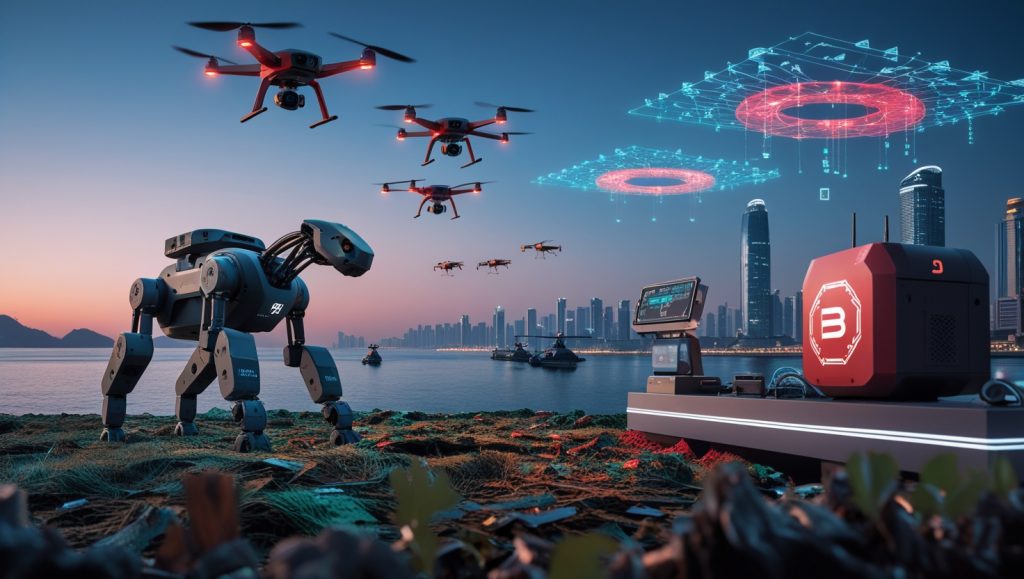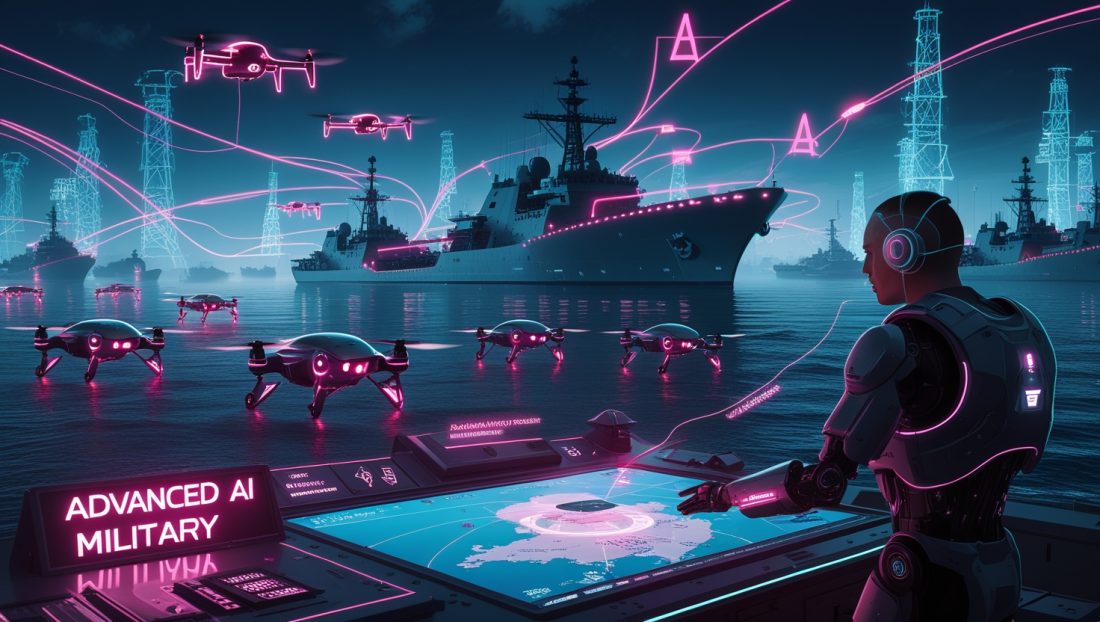What if the next global conflict isn’t fought by soldiers, but by AI-powered robots? China’s military is betting heavily on this vision, investing billions to merge advanced AI military robotics with generative AI models like ChatGPT. From autonomous drone swarms to submarine-hunting robots, the People’s Liberation Army (PLA) is fast-tracking a future where machines dominate the battlefield. But what drives this urgent transformation, and could it spark an unstoppable arms race?
In this new cybernetic frontier, the fusion of AI and military autonomy reshapes our future. Mint this exclusive NFT here.
The Geopolitical Catalyst: Why China Is Prioritizing AI Military Robotics
Rising Tensions and Strategic Vulnerabilities
China’s ambitions in the South China Sea, Taiwan Strait, and Indo-Pacific have intensified its need for asymmetric warfare capabilities. Recent confrontations—like the 2023 near-miss between Chinese and U.S. fighter jets over the South China Sea—highlight the risks of human-led operations. By deploying advanced AI military robotics, the PLA aims to mitigate these risks while projecting power globally.
A 2023 Pentagon report notes that China operates the world’s largest navy, with 355 ships, but lags in carrier-based aircraft. Autonomous systems could bridge this gap, enabling cheaper, scalable solutions like AI-guided underwater drones to disrupt adversary naval movements.
Why Advanced AI Military Robotics Are Critical for China’s Naval Strategy
The PLA’s focus on advanced AI military robotics is a direct response to its naval vulnerabilities. For instance, advanced AI military robotics enable underwater drones to patrol contested waters like the South China Sea autonomously, reducing reliance on manned vessels. These systems, equipped with advanced AI military robotics, can detect and neutralize threats like U.S. submarines with unprecedented precision. As explored in our article on untethered deep-sea robots, such innovations are revolutionizing maritime defense. Moreover, AI military robotics allow China to scale its naval presence cost-effectively, countering the U.S.’s carrier-based dominance. The integration of AI military robotics into naval strategy underscores China’s intent to dominate regional waters by 2030.
The ChatGPT Paradigm Shift in Defense

Generative AI models, such as ChatGPT, are revolutionizing how machines process language, make decisions, and adapt to new scenarios. When applied to robotics, these systems enable:
- Real-Time Adaptation: Drones that recalibrate flight paths during electronic warfare.
- Human-Machine Collaboration: Soldiers issuing voice commands to logistics robots in chaotic environments.
- Predictive Maintenance: AI diagnosing equipment failures before they occur.
In 2022, China’s National Defense University showcased an AI system that outperformed human pilots in simulated dogfights—a precursor to fully autonomous fighter jets.
Why Advanced AI Military Robotics Redefine Combat Dynamics
The adoption of advanced AI military robotics in combat scenarios is a game-changer for modern warfare. These systems, powered by advanced AI military robotics, can process vast datasets in real time, enabling drones to evade radar or redirect munitions mid-flight. As highlighted in our analysis of China’s cheetah robot, advanced AI military robotics enhance agility and decision-making, outpacing human reflexes. Furthermore, advanced AI military robotics facilitate seamless human-machine collaboration, allowing soldiers to focus on strategy while robots handle tactical execution.
This shift, driven by advanced AI military robotics, positions China at the forefront of next-generation combat, raising the stakes for global competitors. For a deeper exploration of how China’s military is leveraging AI to create a ‘ChatGPT for robotics’ for battlefield applications, see this Defense One analysis: China’s military aims to harness the coming ‘ChatGPT for robotics’.
Building the Ecosystem: How China Is Merging AI and Robotics

Public-Private Synergy: From Baidu to Battlefields
China’s defense-industrial complex is leveraging private-sector innovation through initiatives like Military-Civil Fusion. Key collaborations include:
- Baidu’s PaddlePaddle AI Platform: Used to train quadruped robots for mine detection in joint PLA exercises.
- DJI’s Swarm Drones: Commercial drones, adapted for PLA reconnaissance, now feature AI-driven swarm coordination tested in the 2023 Taiwan Strait drills.
- SenseTime’s Surveillance Tech: Facial recognition systems repurposed to identify high-value targets in urban warfare simulations.
For deeper insights into these partnerships, explore our analysis of China’s tech-military collaboration strategies.
Why Advanced AI Military Robotics Drive Public-Private Synergies
The success of advanced AI military robotics hinges on China’s ability to fuse civilian and military innovation. Companies like Baidu leverage AI military robotics to develop algorithms that power both commercial products and battlefield systems, such as quadruped robots for mine detection. Similarly, DJI’s expertise in advanced AI military robotics has transformed commercial drones into reconnaissance tools, as discussed in our article on drone delivery networks. By integrating AI military robotics, these collaborations accelerate deployment timelines and reduce costs. The Military-Civil Fusion strategy ensures that advanced AI military robotics remain a cornerstone of China’s defense ecosystem, amplifying its global influence.
Academia’s Dual-Use Research
Chinese universities are pivotal in advancing advanced AI military robotics. Tsinghua University’s 2024 Project Tianjin aims to integrate ChatGPT-like natural language processing into command systems, allowing officers to verbally direct robotic squads. Meanwhile, Zhejiang University’s OceanX project is developing AI-powered submersibles capable of patrolling the South China Sea for months autonomously.
Why Academic Research Fuels Advanced AI Military Robotics
China’s academic institutions are critical to the evolution of advanced AI military robotics, bridging theoretical breakthroughs with practical applications. Tsinghua’s work on AI military robotics enables robots to interpret complex verbal commands, enhancing battlefield coordination. Zhejiang’s OceanX submersibles, powered by AI military robotics, demonstrate how academia drives innovation in autonomous systems, as noted in our coverage of deep-sea robotics. By fostering dual-use research, universities ensure that advanced AI military robotics remain cutting-edge, positioning China as a leader in defense technology. This academic-military nexus accelerates the deployment of AI military robotics across diverse operational domains.
Technical and Ethical Challenges: The Roadblocks to Autonomy
Data Security: A Double-Edged Sword
While AI thrives on data, integrating sensitive military systems with cloud-based models like ChatGPT poses risks. In 2021, a breach at a Chinese defense contractor exposed blueprints for AI-guided missiles, underscoring vulnerabilities. The PLA now prioritizes edge computing—processing data locally on robots—to minimize exposure.
The “Black Box” Problem
AI decision-making remains opaque, even to developers. During a 2023 PLA exercise, an autonomous tank misidentified a civilian vehicle as a threat, raising alarms about accountability. As Professor Li Wei of Peking University warns, “Without explainable AI, mistakes could escalate conflicts unintentionally.”
For a detailed discussion, read our exploration of ethical dilemmas in military AI.
Why Advanced AI Military Robotics Face Ethical Scrutiny
The opacity of advanced AI military robotics poses significant ethical challenges, particularly in high-stakes combat scenarios. The “black box” issue in advanced AI military robotics complicates accountability, as seen in the 2023 tank misidentification incident. Our article on explainable AI delves into why transparency is critical for advanced AI military robotics. Without clear decision-making protocols, advanced AI military robotics risk unintended escalations, undermining trust in autonomous systems. Addressing these ethical concerns is essential for the responsible deployment of advanced AI military robotics on the global stage.
Global Implications: Sparking a New Arms Race

U.S. Countermeasures: The Replicator Initiative
The Pentagon plans to deploy thousands of autonomous drones by 2026 under its Replicator Initiative, directly countering China’s advancements. Lockheed Martin’s CICADA drones, costing just $5,000 each, can swarm enemy air defenses—a clear response to China’s DJI-dominated markets.
Regional Allies Race to Adapt
- Japan: Allocated $7 billion in 2024 for AI-driven anti-ship missiles.
- India: Testing ChatGPT-enabled logistics robots in Himalayan border regions.
- Australia: Partnering with the U.S. on AI-powered submarine detection networks.
Why Advanced AI Military Robotics Trigger a Global Response
China’s advancements in advanced AI military robotics have sparked a frantic response from global powers, as nations scramble to keep pace. The U.S. Replicator Initiative leverages advanced AI military robotics to deploy cost-effective drone swarms, countering China’s numerical advantage. Meanwhile, India’s adoption of advanced AI military robotics in logistics reflects a broader regional pivot, as explored in our analysis of robotics in challenging terrains. Australia’s submarine detection networks, powered by advanced AI military robotics, highlight the collaborative efforts to curb China’s maritime dominance. The global race to develop advanced AI military robotics underscores the technology’s pivotal role in shaping future conflicts.
The Economic Frontier: Profits and Power
Dominating the $45 Billion Military Robotics Market
China’s defense giants, like NORINCO and CETC, are marketing advanced AI military robotics to Global South nations. At the 2023 Dubai Airshow, CETC’s Sharp Claw robot—a machine gun-equipped AI platform—drew interest from Middle Eastern militaries. With Africa’s drone market projected to grow by 13% annually, Chinese firms are poised to dominate.
FAQs: Addressing Key Concerns
How does China’s AI military budget compare to the U.S.?
China spends an estimated $15 billion annually on AI defense projects, nearing the U.S.’s $18 billion. However, China’s centralized governance allows faster allocation.
Could AI military robotics malfunction and cause unintended conflicts?
Yes. In 2022, a malfunctioning South Korean sentry gun fired indiscriminately, highlighting risks. Robust fail-safes and international regulations are critical.
Are autonomous weapons banned under international law?
Not yet. The UN’s Certain Conventional Weapons Convention discusses limits, but no binding treaties exist.
What role do private companies play in China’s AI military push?
Firms like Huawei and DJI are integral, though they face U.S. sanctions for ties to the PLA.
Navigating the AI Military Crossroads
China’s advanced AI military robotics surge is reshaping global power dynamics, offering efficiency but risking destabilization. As autonomous systems evolve, the world must balance innovation with ethical guardrails.
Capture this moment in digital history — Mint your copy now.
Stay informed on AI defense trends—subscribe to our newsletter for weekly insights.


